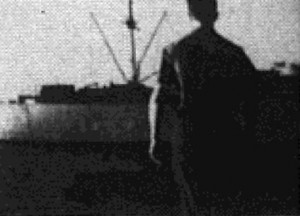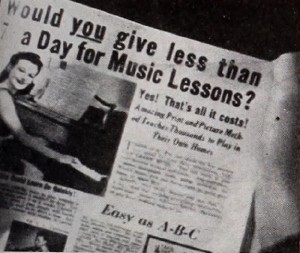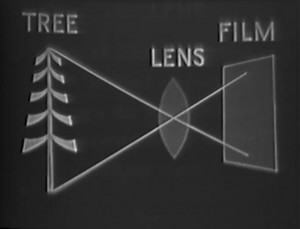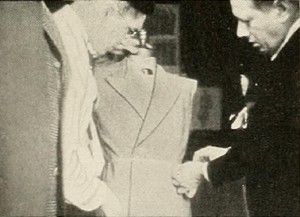
"Lemmings, mouselike rodents of the northern regions, for reasons not fully understood, will move in great numbers to the edge of the cliff and jump into the water and swim on until exhausted and drown. Hence the name of this short story of a man lured by some type of hypnosis set up by a constant sounds from the sea. He moves thru the busy city streets to the end of the dock in the short interval of mid-afternoon to dusk,"PSA Journal, Oct. 1962, 35.

"Lend Me Your Ear is an almost perfect synthesis of shrewd planning, impeccable camera work, smoothly integrated music and general, overall charm. It is gay, glamorous and in good taste. In it, Erma Niedermeyer has caught the lighthearted spirit of 'teen aged American youth. That she was amply aided by her own attractive son was her further good fortune. As the film opens, the Boy is discovered musing over that classic advertisement which guarantees to teach you piano in ten easy lessons. "You too can be the life of the party!" it clarions. The Boy answers the call, the lessons start arriving and the fun begins. There is the light "running gag" of the harried postman, continually overwhelmed by the Boy's enthusiasm as he delivers each new installment; there is the time the piano refuses to play, clogged up as it is by a basketball in its "innards"; there is the tousle headed imitation of Franz Liszt at the age of fourteen — and more. There is, in climax, the Boy's devastating triumph amid a bevy of admiring beauties, as he becomes in truth "the life of the party." Geared to these sequences — which are presented in swift pace and with unerring command of the camera — is a musical accompaniment as suave as the film itself. A single commercial recording provides a slight and recurring background theme. All the remaining score — from the first hesitant scales to the final rocking rendition of a jazz hit — is in the Boy's own playing, especially recorded by Mrs. Niedermeyer to fit her own picture. It is an ineffable and irresistible combination, this Lend Me Your Ear, warmly deserving of the high honor it has won." Movie Makers, Dec. 1943, 457.
"Edited film created by Frank L. Kreznar, an award winning amateur filmmaker, with assistance from his wife during a guided tour of the Soviet Union in 1965. Film consists of footage of Moscow and Leningrad mainly of public places with a special emphasis on historically important buildings. Throughout the footage Kreznar shows modern apartment buildings as they are being constructed, with his commentary discussing the Soviets’ efforts to modernize the territories under their control and the recent population growth in these cities. Kreznar is also interested in the modes of public transportation in each city – such as street cars or the metro in Moscow. Kreznar notes that most automobile production in the Soviet Union focuses on trucks for work while cars are considered a rare luxury for private citizens. He also discusses the high volume of pedestrian traffic. Kreznar also takes an interest in religion in this footage, showing churches in disrepair or having been de-sanctified and converted into housing, museums, or other government administrated buildings. Kreznar notes that this is due to the Soviet government’s anti-religious policy, but he also shows some churches under recently started restoration due to the government’s realization of the touristic value of these sites. Film includes occasional shots of people working, mainly in outdoor produce markets. Women are shown doing road construction in Moscow as well as various public parks, swimming pools, and other public recreation areas, with a special emphasis on how the Soviet government has given children places to play," Human Studies Film Archives, Smithsonian Museum.

"On use of camera lenses to produce desired photographic effect. Demonstrates functions of different lenses." National Archives.
Later reworked as Meditation in the Hills (Richard H. Jobson, 1952), winner of Amateur Cine World 3-Star Award in 1953 Ten Best Competition, UK.

"Kendall T. Greenwood has told an interesting and uniformly attractive story of one of America's great integrated industries in Let Your Body Breathe. From the original Goodall Company plant in Sanford, Maine, to the elaborate retailing methods of the present day, the film presents a clear cut picture of Palm Beach cloth and its part in the modern pattern of warm weather living. Designed primarily for use within the trade, Let Your Body Breathe shows the retailer all the important points in the manufacture of this fabric, its tailoring by the parent company into suits and sportswear and the continued control over the product, even to such details as proper laundering or cleaning. Mr. Greenwood's camera work is crisp, his editing incisive, while the narrative contributes judiciously to an able industrial record." Movie Makers, Dec. 1941, 568.
"Canada 1960." UCLA Film & Television Archive.
Total Pages: 299